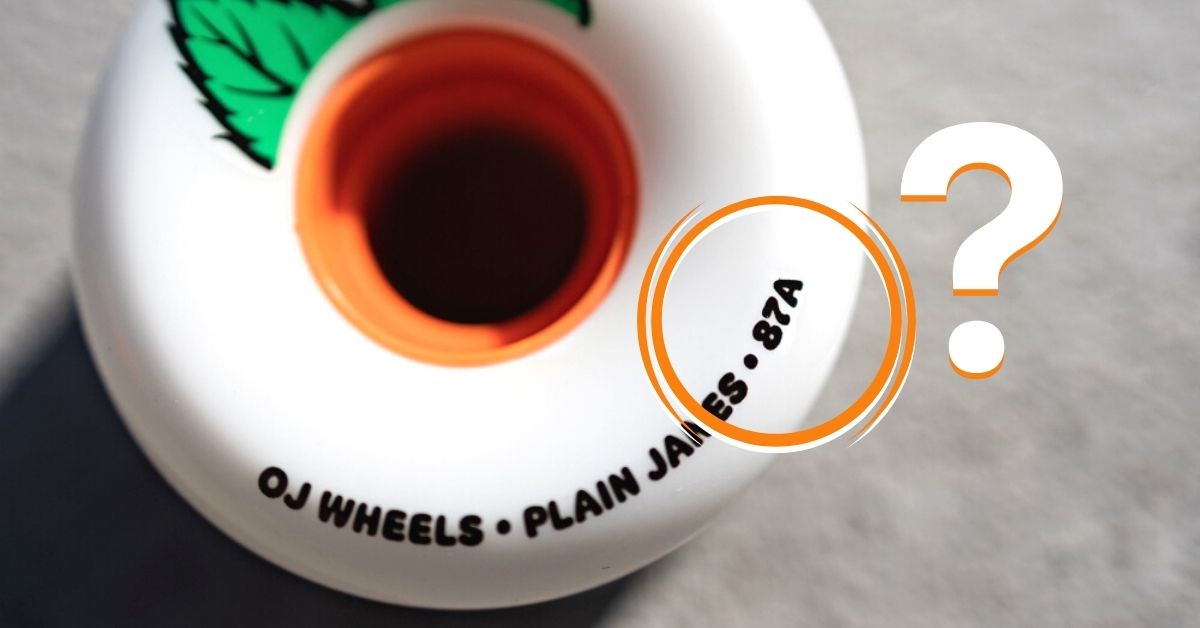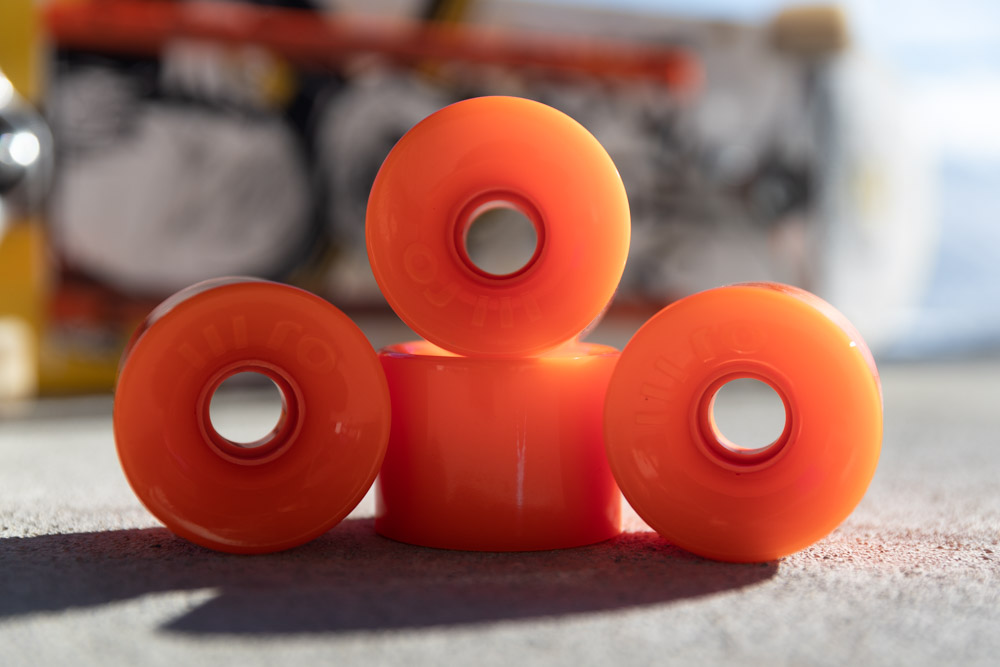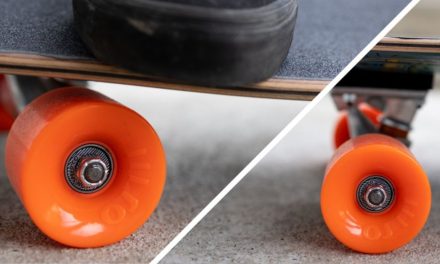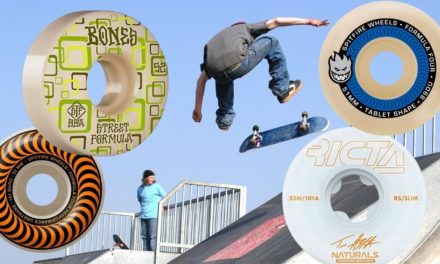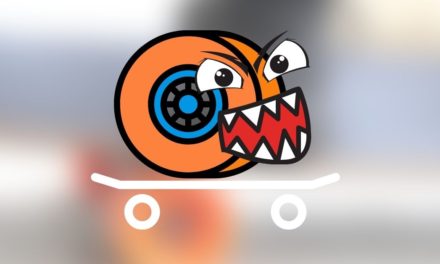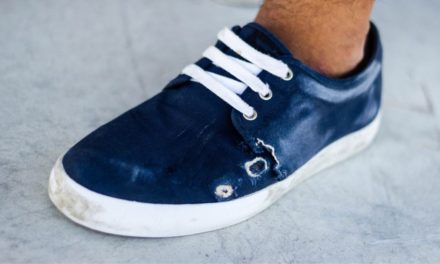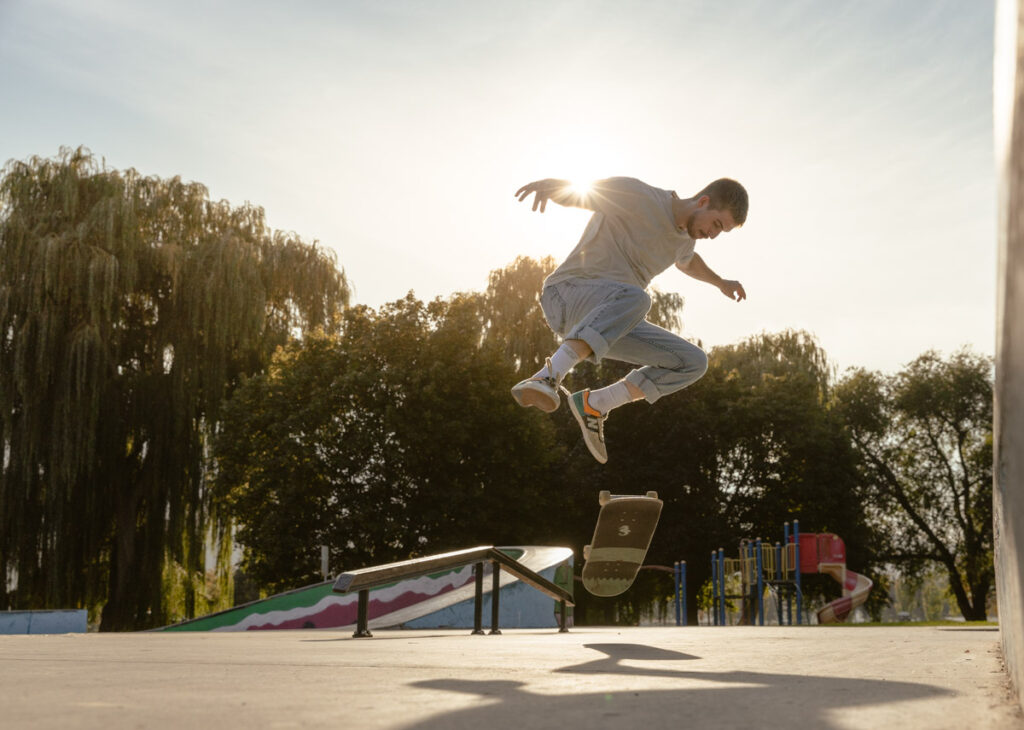Besides finding the right diameter of wheel, the hardness of a skateboard wheel makes a big impact on how they roll too. So when comparing soft vs. hard skateboard wheels, it’s hard to tell which option is right for you, especially if you haven’t felt the difference for yourself. Luckily, it’s easy to choose which type of wheel to go with based on your skating style.
Soft skateboard wheels have a durometer of 78a to 87a and are good for rolling on rough concrete and improving your grip. Hard skateboard wheels have a durometer of 97a – 104a and are best for smooth concrete and skateparks. Soft wheels are best for cruising, while hard wheels are best for tricks.
If this is your first time looking at durometer ratings, “78a” or “104a” likely makes zero sense. Fortunately, this durometer scale is simple to understand and will help you quickly identify which wheels are right for you. So let’s first break down the A and B scales of durometer rating, then go over the pros and cons of soft vs. hard skateboard wheels to help you find the perfect wheel hardness!
Understanding Skateboard Wheel Durometer – A & B Scales
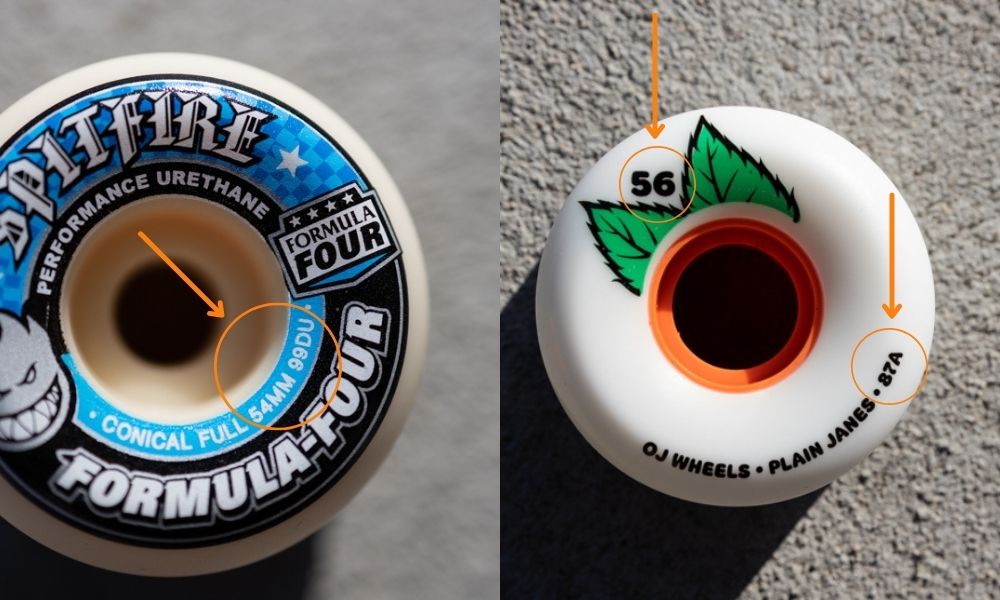
Wheel durometer measures how hard or soft a wheel is on a scale of 0 to 100, with a harder wheel being rated closer to 100. For example, on many skateboard wheels, you’ll see a rating such as 92A or 101A, with the 92A wheel being softer than the 101A wheel because of the 100 point scale.
The “A” beside the scale rating indicates which scale is being used. In the case of the 92A and 101A wheel, the A-scale is being used to measure the durometer.
In some instances, manufacturers will use the B-scale to measure the durometer, which is the equivalent of 20 points less than the A-scale. That means that a wheel rated 79B is the same hardness as a 99A wheel. Likewise, an 83B wheel is the same hardness as a 103A wheel, which is considered very hard.
The A and B scale can be confusing when looking for a new set of wheels because although 83B may sound like a softer wheel, it’s actually a very hard one. Taking note of the A or B beside the durometer rating is important, so you don’t get any surprises when you start skating!
An exception to this is Spitfire, which uses a “D” rating which stands for Durometer. Luckily if you consider it the same as the A scale, it’s easy to understand. So, for example, a 99D wheel from Spitfire is the same as a 99A wheel from another wheel brand.
The Performance Of Soft Vs Hard Wheels
A soft skateboard wheel is far better at absorbing vibrations and bumps, which makes them ideal for skating on rough roads or cruising around town. Since the wheel is softer, it’s also tackier and harder to slide, therefore giving you a lot more grip when leaning hard into a turn.
Meanwhile, a hard skateboard wheel is better at holding speed and accelerates faster on smooth concrete. Especially for skateparks, a harder wheel is a better option to go with. Although a hard skateboard wheel has less grip than a soft wheel, it’s easier to pivot and slide out of tricks which is helpful for board slides and rotational tricks such as frontside flips, 180s, or big spins.
What Are Soft Wheels Good For?
Like I mentioned above, soft wheels are ideal for rough roads and cruising. Compared to a hard wheel on your average street or sidewalk, there’s a lot less vibration, making for a more comfortable ride. If you primarily skate to work or school and tricks aren’t your main concern, soft wheels are absolutely the way to go.
A soft wheel has a durometer in the range of 78A – 87A, with the lower rating being better for cruising. However, a higher durometer like 87A is better if you want to pop the occasional trick or roll around the skatepark from time to time.
The downside of soft skateboard wheels comes when you want to start doing tricks. Since softer wheels have more grip, it takes a lot more force to slide your wheels on the ground. Also, it’s noticeably more difficult with a soft wheel to pivot out of tricks or getting into a powerslide.
To give you an example, I find board slides much harder with soft wheels since you need to make sure your board’s positioned back to the direction you’re traveling before you touch the ground. With a harder wheel, you can pivot out even if you didn’t rotate back to normal from the board slide, which gives some more room for error.
Likewise, any tricks involving 180s or 360s need to be fully rotated, or else the soft wheels stick to the ground like glue, making the tricks more difficult.
So ultimately, soft skateboard wheels are best for those who want to cruise around and aren’t focused on landing hammers down a 12-stair down rail. Here’s a quick summary to compare the differences.
Advantages Of Soft Wheels:
- Smoother On Rough Concrete
- Superior Grip
- Can Be Ridden Comfortably On Smooth Concrete Too
Downsides Of Soft Wheels:
- Not Great For Tricks
- Don’t Roll As Fast On Smooth Concrete
What Are Hard Skateboard Wheels Good For?
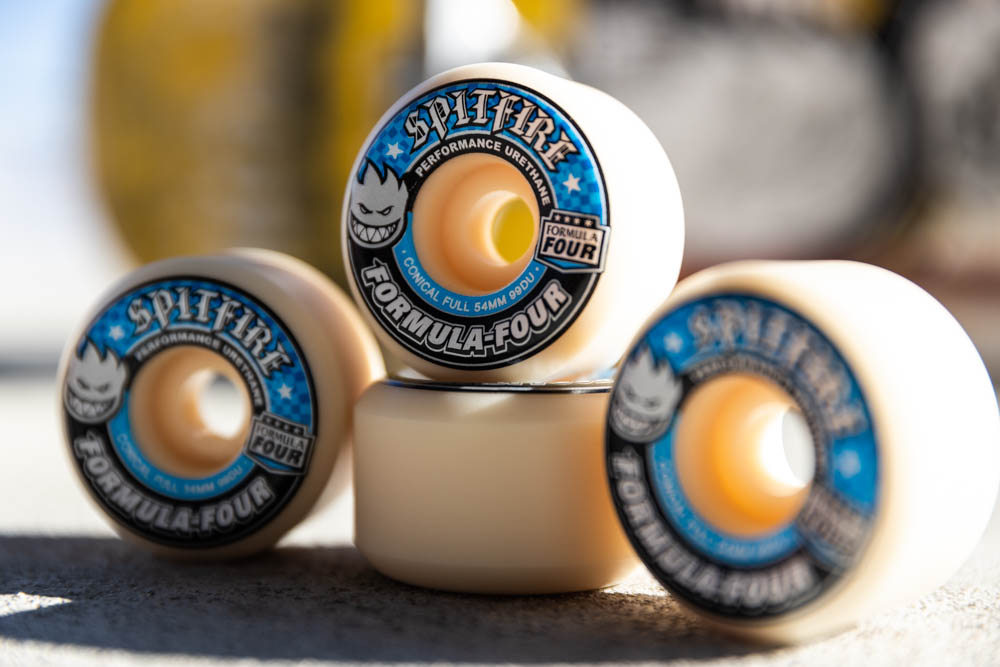
On the other hand, hard skateboard wheels fill in the gaps where soft wheels are lacking. Hard wheels are meant for smoother concrete, such as at the skatepark, and are more maneuverable for flat-ground, rail, or ledge tricks. For skaters who are focused on landing their first kickflips, working a new feature at the skatepark or riding bowls, hard wheels are the way to go.
A hard wheel has a durometer in the range of 99A to 104A, with the highest rating being best for tech tricks on most smooth surfaces. A lower rating like 99A is a more all-around option that can still slide when you need it but still has a decent grip when leaning hard into a turn.
Since hard wheels are meant for smoother surfaces, skating them on rough roads or around town isn’t exactly comfortable. The vibrations will make your leg feel like it’s asleep, and every bump is that much more noticeable. This isn’t much of an issue if you don’t skate anywhere besides the skatepark or your favorite street spot with buttery concrete. However, for skaters who skate to and from the skatepark or like to skate spots with rougher concrete, a hard wheel may not be ideal.
Another thing to consider is exactly how smooth the concrete you’re skating is since many new skateparks have more polished concrete than older, more worn parks. This polished concrete can be a massive pain when skating very hard wheels like 101A and above. It almost feels like you’re skating on soap at times which can make your session pretty miserable. That’s why the best all-around option (and most popular) hard wheel durometer is 99A since it has a bit more grip than the extremely hard wheels.
So, in a nutshell, if you want a great overall wheel for tricks and smooth concrete, opt for a 99A durometer. However, if tech tricks are your main focus, a harder wheel such as 101A and above is the way to go.
Advantages Of Hard Wheels:
- Great For Technical Tricks
- Rolls Faster On Smooth Concrete
- Good For Bowl & Pool Skating
Downsides Of Hard Wheels:
- Miserable On Rough Concrete
- Less Grip When Laying Into Turns
“In-Between” Wheel Durometers
When considering wheel durometers, there are wheels that aren’t quite soft, aren’t quite hard, but sit somewhere in the middle. These wheels have a durometer of 92A to 95A and offer a more versatile wheel if you are someone who skates at the skatepark, out in front of your house, and grungy street spots with awful pavement.
In this range, you can still slide your wheels (although it takes more effort), and they are still responsive enough for tech tricks, rails, and stairs. To add to this, the slightly softer wheel durometer makes rough pavement feel smoother to skate, giving you the best of both worlds between hard and soft skateboard wheels.
The downside to this wheel durometer is that it’s good enough for just about everything but not the best at anything. Being slightly softer, 92A – 95A wheels won’t hold speed as well on smooth concrete, such as a 99A+ wheel would. Likewise, they won’t feel as smooth on rough concrete as a 78A cruiser wheel would, for example.
That’s why this wheel durometer is worth considering if you’re someone who skates at both the skatepark and in the streets. Think of these “in-between” durometers as a do-it-all-wheel if you don’t skate the same place every day.
Advantages Of “In-Between” Wheels:
- Good For Smooth & Rough Concrete
- Good For Tricks While Being Comfortable To Cruise
- Grippy But Still Can Slide
Downsides Of “In-Between” Wheels:
- Won’t Roll As Fast On Smooth Concrete
- Not As Comfortable On Rough Concrete As A True Soft Wheel
Should You Choose A Soft Or Hard Skateboard Wheel?
Like choosing your favorite skate brand, choosing soft or hard wheels is somewhat subjective. Although there are obvious pros and cons to each option, you may be a skatepark ripper who simply prefers the feeling of a softer wheel like 92A. Since I can’t tell you exactly which wheel to go with, below is a table to offer a guideline of which durometer may be best for your skating.
| Skating Style | Recommended Hardness | Recommended Durometers | Recommended Diameter |
|---|---|---|---|
| Skateparks | Hard | 99A+ | 52mm – 55mm |
| Bowl & Transition | Medium / Hard | 97A – 101A | 55mm – 58mm |
| Cruising & Commuting | Soft | 78A – 87A | 58mm – 60mm+ |
| Street Skating | Medium | 92A – 97A | 52mm – 53mm |
| Flat Ground | Hard | 101A – 104A | 50mm – 53mm |
| Beginner | Medium / Hard | 92A – 99A | 54mm – 56mm |
If you are looking at wheels with a diameter of 58mm and above, you will want to consider a 1/4″ or 1/2″ riser pad to help avoid wheel bite.
So ultimately, the wheel hardness you choose to skate comes down to your skating style. For most situations involving tricks or high speeds, an “in-between” hardness or a hard wheel is the best option to go with (92A – 104A). Just consider what type of concrete you’ll be skating on since very hard wheels feel terrible to skate on rough surfaces. On the other hand, if tricks aren’t your thing and you want a comfortable cruiser board, a softer wheel will be a better option.
Other Factors That Affect Skateboard Wheel Performance
Besides the durometer of your wheel, there are two other things to consider before buying a set of skateboard wheels.
– Wheel Size
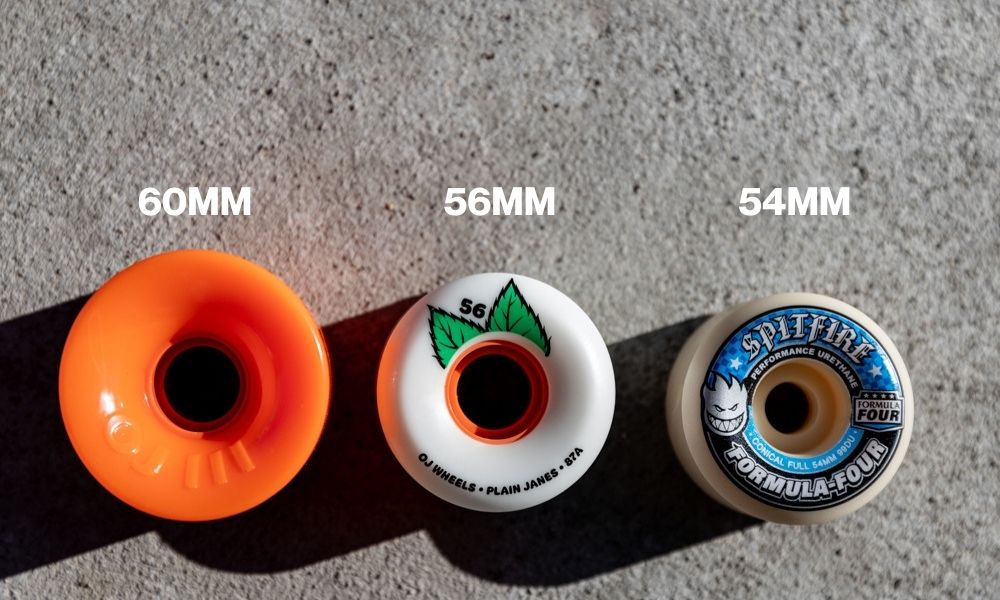
Wheel size, aka wheel diameter, is the size of your wheel measured in millimeters. Larger wheels are far better at holding speed and allow you to roll farther with less effort. The downside, however, is that they are heavier and slower to accelerate. So when trying tech tricks or skating a spot with a short run-up, a larger wheel diameter will be a hindrance. On the flip side, if you’re skating bowls, ripping the skatepark, or going on a cruise around town, a larger wheel will offer a more enjoyable ride.
With small wheel diameters, you get the exact opposite effect. Small wheels accelerate faster but don’t hold speed and have a lower top speed. These wheels are also lighter, making your board feel more tactile when flipping tricks. It’s a slight trade-off that can be beneficial if street-style trick skating is your primary focus.
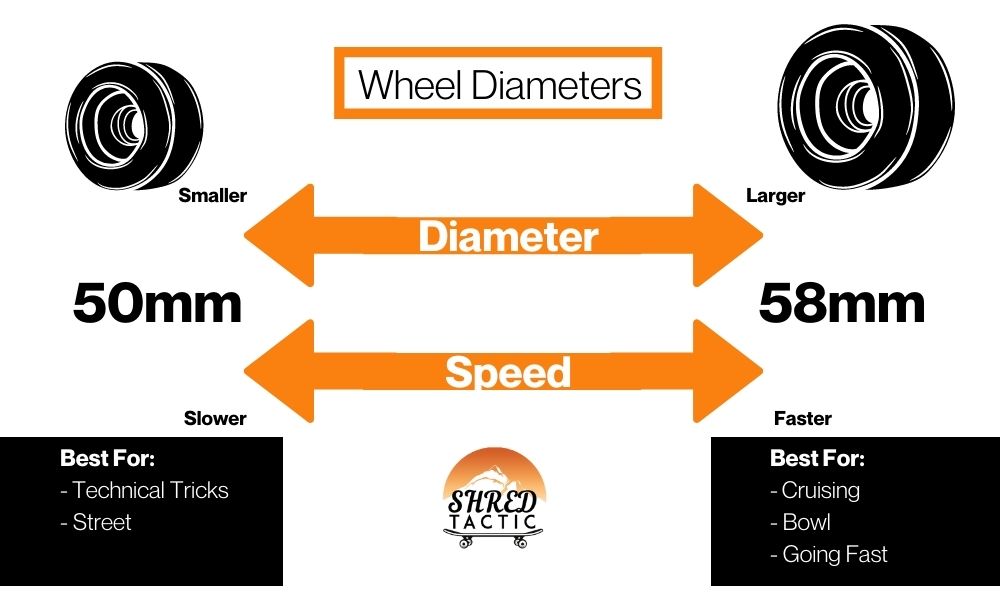
In general, a large wheel could be considered as anything 55mm and above. A small wheel would be 54mm, and below; however, 54mm is sort of a middle ground between the two wheel sizes, offering favorable aspects of both wheel sizes.
– Urethane Quality
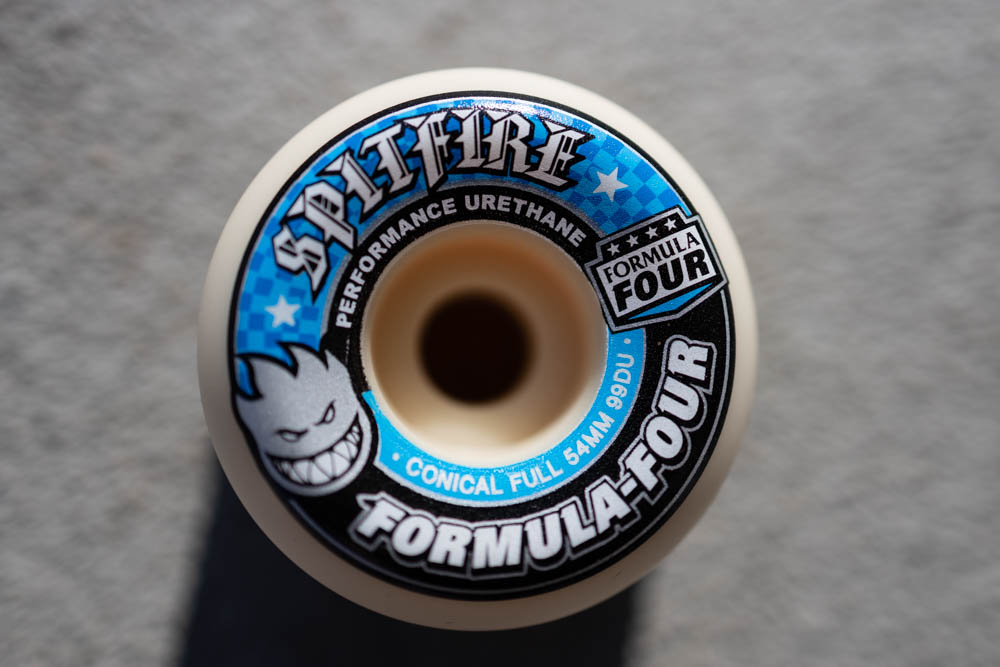
With different skateboard wheel brands come different qualities of urethane, durability, and rebound. In general, a skateboard wheel with a higher quality urethane will have better durability and be less prone to flat spots while also having good rebound.
Rebound is essentially how quickly a wheel snaps back into shape after it’s compressed. When landing a trick, your wheels are put under a ton of pressure which compresses the wheel. A wheel with a good rebound will quickly snap back into shape, which will also help with the continued momentum of the wheel.
You can test the level of rebound by bouncing a wheel against the ground. Comparing a hard wheel to a softer one, harder wheels tend to have more rebound since there is more energy when it snaps back into shape. Conversely, softer wheels absorb the impact more and have a slower rebound, so they won’t bounce as high during a drop test. With that said, harder wheels take far more energy to compress, so dropping soft and hard wheels from a low height without load can give skewed results.
Unfortunately, there’s no particular way to see which wheel has the best urethane quality; however, going with reputable brands is the safest bet. Spitfire, Bones, and Ricta are just a few of the most popular skateboard wheel brands to go with since they have top-of-the-line urethane.
Now that you have a better idea of whether a hard or soft skateboard wheel is best for you, here are some other articles to help you find the right skateboard wheels:
- Best Skateboard Wheels For Beginners
- Best Skateboard Wheels For Tricks & Street
- Best Skateboard Wheels For Bowl
- Best Skateboard Wheels For Skateparks
Happy Shredding!
Brendan 🙂

